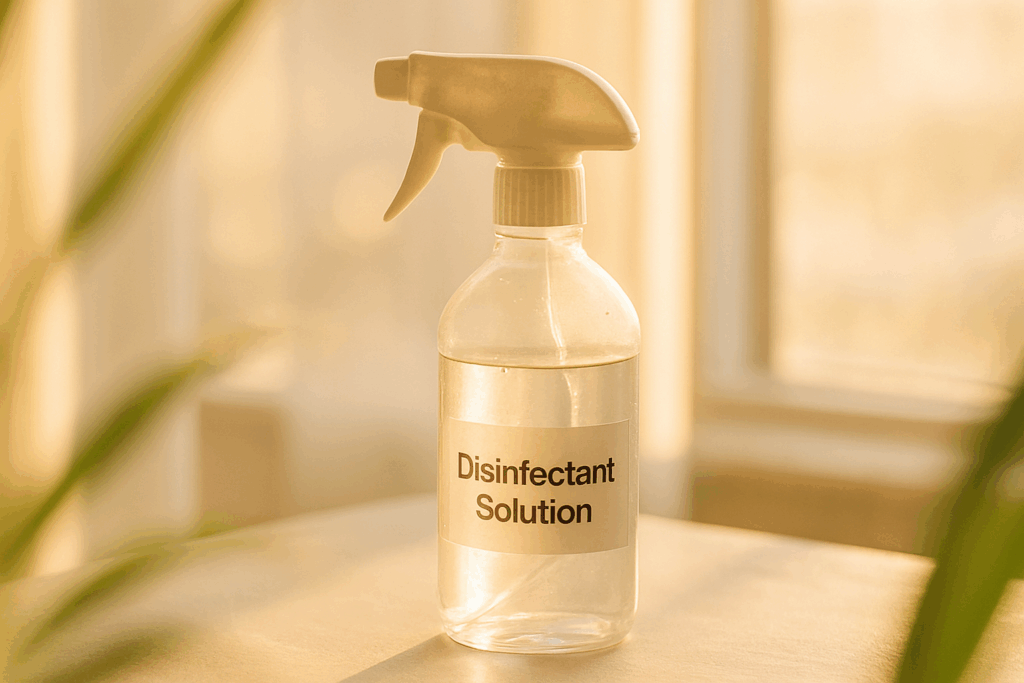What Hypochlorous Acid Actually Is
Hypochlorous acid (HOCl) might sound clinical, but it’s actually something your body already knows how to make and use.
Your Body’s Natural Defender
HOCl is a naturally occurring substance produced by your white blood cells.
Its primary function? To fight harmful bacteria, defend damaged tissue, and support your immune system.
Powerful, Yet Surprisingly Gentle
Though potent against pathogens, hypochlorous acid is unusually skin friendly:
Chemically speaking, it’s both an oxidant and a biocide but don’t let that scare you.
Compared to other active ingredients, HOCl is remarkably gentle, making it ideal for sensitive skin or for those prone to irritation.
The Healing Mission
In your body, HOCl acts like a first responder:
Disinfects areas under attack by neutralizing viruses, bacteria, and other invaders.
Helps accelerate tissue repair by reducing inflammation and promoting cell turnover.
In short, what your body uses to keep internal wounds clean and heal faster is now showing promise as a topical skincare hero.
Why Skincare Brands Are Finally Paying Attention (2026 Update)
From First Aid Cabinet to Skincare Shelf
Once used primarily as a wound disinfectant, hypochlorous acid (HOCl) is now emerging as a standout ingredient in modern skincare. Thanks to its gentle yet effective profile, brands are embracing HOCl as more than just an antibacterial it’s becoming a skincare multitasker.
Initially developed for cleaning wounds and surgical sites
Now repurposed by skincare experts as a gentle treatment for everyday use
A Gentler Alternative to Traditional Acne Treatments
Unlike benzoyl peroxide or salicylic acid, HOCl offers antibacterial support without the unwanted side effects.
Minimal irritation and dryness, even for sensitive skin
No stinging, peeling, or harsh stripping
Suitable for all skin types, including reactive or allergy prone
Healing Support for Sensitive and Stressed Skin
HOCl has gained a loyal following among users healing from procedures or struggling with recurring breakouts.
Calms irritated skin after microneedling, laser sessions, or dermaplaning
Helps reduce downtime and speeds up visible recovery
Lightweight mist formulas often double as soothing toners
Safe, Simple, and Ideal for Daily Use
One of HOCl’s biggest wins? It requires no ingredient overhauls or complicated routine shifts.
Fragrance free and minimal in formulation
Non toxic, non comedogenic, and safe during pregnancy
An easy add on to sensitive skin rituals or minimalist routines
Benefits You Can’t Ignore
Let’s keep it simple: hypochlorous acid works without wrecking your skin. First off, it fights acne causing bacteria with surgical precision but doesn’t leave your skin raw or flaky. Unlike harsh treatments that tear down your barrier in the name of ‘clarity,’ this one knows how to kill the bad stuff while keeping your moisture intact.
It’s also fast when it comes to inflammation. Whether you’re dealing with a surprise breakout, irritation from a new product, or just that post sun redness, hypochlorous acid steps in to calm things down quickly. It doesn’t mask the problem it helps neutralize it.
Skin healing? This is where it really earns a spot in your lineup. If you’ve just had microneedling, laser work, or an accidental sun fry, HOCl can speed up recovery without causing flare ups. It supports the natural rebuild process think less peeling, less downtime.
Lastly, it gives your skin a defensive edge. HOCl doesn’t just react to problems; it helps your skin stay ready. It reinforces your skin’s own immune function, so you’re less likely to break out or flare up in the first place.
Powerful and gentle rare combo, but this one pulls it off.
Where It Fits in Your Routine

Think of hypochlorous acid (HOCl) as your skin’s peacekeeper. It slides right into your routine between cleansing and moisturizing just mist it on like a treatment step. Easy, no frills.
The real beauty of HOCl? It’s team friendly. It works well alongside ingredients like niacinamide, hyaluronic acid, and ceramides. You don’t have to overhaul your entire lineup or worry about chemical tantrums. There are no known clashes with common skincare actives, and it rarely triggers irritation on its own.
If you’re someone who’s already using multiple actives think acids, retinoids, or exfoliators HOCl helps keep inflammation in check. It gives your skin a buffer while still doing the behind the scenes work of calming, repairing, and keeping bacteria at bay. When your skin feels edgy from too many products, HOCl steps in as the quiet fixer.
Bonus read: Learn how niacinamide pairs with HOCl for barrier boosting, breakout busting routines.
What to Look For on the Label
Not all hypochlorous acid products are created equal. If you want results not just fancy packaging you’ll need to get a little picky with what’s on the label. First, make sure “Hypochlorous Acid” or “HOCl” is listed clearly as the main active ingredient. Avoid anything where it’s buried in a long list of filler ingredients or where the concentration isn’t specified at all.
Next, check the pH. The skin’s natural pH hovers around 5.5, and the best HOCl products stick close to that level. Formulas that are too acidic or too alkaline run the risk of irritation, even with a gentle compound like HOCl. When in doubt, look for products that promote themselves as “pH balanced” but also verify it in the product details.
Lastly, packaging matters more than you think. HOCl is both light and air sensitive, which means clear bottles, jars with screw tops, or anything that lets in a lot of oxygen will wreck its potency fast. Go for products in opaque, air tight containers think pump bottles or sealed atomizers that protect the formula from breakdown.
Bottom line: If you’re going to invest in hypochlorous acid, make sure it’s stable, skin friendly, and upfront about its ingredients. No cutting corners.
The Future of Hypochlorous Acid in Skincare
What was once a niche solution in first aid aisles is now making its way into high end skincare lines. By 2026, expect to see hypochlorous acid (HOCl) not just in sprays but in serums, gels, and lightweight creams, often taking center stage as the main active. Brands know the market is looking for calm over chaos and HOCl delivers.
Dermatologists continue to vouch for it, especially in cases where typical treatments fall short. Skin concerns like maskne, rosacea, and mild eczema benefit from HOCl’s ability to kill bacteria without throwing the skin barrier into crisis. It soothes, disinfects, and supports healing all in one.
The trend isn’t just about ingredient lists. Formulators are being more intentional with how HOCl is packaged and stabilized to extend shelf life and keep it effective. You’ll see more opaque bottles, airless pumps, and claims around purity and pH balance. Bottom line: the gentle germ killer is stepping onto the main stage and it’s here to stay.
Bottom Line: Why Hypochlorous Acid Deserves a Spot in Your Routine
If your goal is to achieve clean, calm, and healthy skin without layering on harsh or sensitizing ingredients hypochlorous acid (HOCl) deserves your attention. Unlike many trendy actives with trade offs, HOCl offers wide reaching benefits with minimal risk.
Why It Stands Out
Gentle yet effective: Great for sensitive or compromised skin
Multitasks naturally: Fights bacteria, calms irritation, and helps repair skin all in one step
Plays well with others: Integrates easily into almost any routine
Who It’s Best For
Acne prone skin types needing antibacterial support
Sensitive or reactive skin in search of gentler solutions
Anyone recovering from treatments like microneedling or laser therapy
Final Thought
Hypochlorous acid may not be the flashiest ingredient on your shelf, but its science backed benefits and skin soothing properties make it one of the most underrated heroes in modern skincare. As more brands embrace its potential, now’s the time to explore what HOCl can do for your skin’s overall health.
